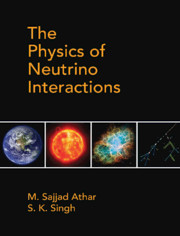Book contents
- Frontmatter
- Dedication
- Contents
- List of Figures
- List of Tables
- Preface
- Acknowledgments
- Chapter 1 Neutrino Properties and Its Interactions
- Chapter 2 Relativistic Particles and Neutrinos
- Chapter 3 Quantization of Free Particle Fields
- Chapter 4 Interacting Fields and Relativistic Perturbation Theory
- Chapter 5 Phenomenological Theory I: Nuclear β-decays and Weak Interaction of Leptons
- Chapter 6 Phenomenological Theory II: Weak Decays of Hadrons
- Chapter 7 Gauge Field Theories and Fundamental Interactions
- Chapter 8 Unified Theory of Electroweak Interactions
- Chapter 9 Neutrino and Electron Scattering from Point Particles
- Chapter 10 Neutrino scattering Cross Sections from Hadrons: Quasielastic Scattering
- Chapter 11 Neutrino Scattering from Hadrons: Inelastic Scattering (I)
- Chapter 12 Neutrino Scattering from Hadrons: Inelastic Scattering (II)
- Chapter 13 Neutrino Scattering from Hadrons: Deep Inelastic Scattering
- Chapter 14 Weak Quasielastic v(⊽)-nucleus Scattering
- Chapter 15 Inelastic Scattering of (Anti)neutrinos from Nuclei
- Chapter 16 Deep Inelastic Scattering of (Anti)neutrinos from Nuclei
- Chapter 17 Neutrino Sources and Detection of Neutrinos
- Chapter 18 Neutrino Mixing and Oscillations
- Chapter 19 Neutrino Astrophysics and the Synthesis of Elements
- Chapter 20 Neutrino Interactions Beyond the Standard Model
- Appendices
- Appendix A Lorentz Transformation and Covariance of the Dirac Equation
- Appendix B Cabibbo Theory
- Appendix C Some Properties of Pauli and Dirac Matrices and Spin Density Matrices
- Appendix D Leptonic and Hadronic Tensors
- Appendix E General Expression for the Total Scattering Cross Section and Decay Rates
- Appendix F Expressions of N(q2), the Coefficients of the Polarization Observables
- References
- Index
Appendix C - Some Properties of Pauli and Dirac Matrices and Spin DensityMatrices
Published online by Cambridge University Press: 22 May 2020
- Frontmatter
- Dedication
- Contents
- List of Figures
- List of Tables
- Preface
- Acknowledgments
- Chapter 1 Neutrino Properties and Its Interactions
- Chapter 2 Relativistic Particles and Neutrinos
- Chapter 3 Quantization of Free Particle Fields
- Chapter 4 Interacting Fields and Relativistic Perturbation Theory
- Chapter 5 Phenomenological Theory I: Nuclear β-decays and Weak Interaction of Leptons
- Chapter 6 Phenomenological Theory II: Weak Decays of Hadrons
- Chapter 7 Gauge Field Theories and Fundamental Interactions
- Chapter 8 Unified Theory of Electroweak Interactions
- Chapter 9 Neutrino and Electron Scattering from Point Particles
- Chapter 10 Neutrino scattering Cross Sections from Hadrons: Quasielastic Scattering
- Chapter 11 Neutrino Scattering from Hadrons: Inelastic Scattering (I)
- Chapter 12 Neutrino Scattering from Hadrons: Inelastic Scattering (II)
- Chapter 13 Neutrino Scattering from Hadrons: Deep Inelastic Scattering
- Chapter 14 Weak Quasielastic v(⊽)-nucleus Scattering
- Chapter 15 Inelastic Scattering of (Anti)neutrinos from Nuclei
- Chapter 16 Deep Inelastic Scattering of (Anti)neutrinos from Nuclei
- Chapter 17 Neutrino Sources and Detection of Neutrinos
- Chapter 18 Neutrino Mixing and Oscillations
- Chapter 19 Neutrino Astrophysics and the Synthesis of Elements
- Chapter 20 Neutrino Interactions Beyond the Standard Model
- Appendices
- Appendix A Lorentz Transformation and Covariance of the Dirac Equation
- Appendix B Cabibbo Theory
- Appendix C Some Properties of Pauli and Dirac Matrices and Spin Density Matrices
- Appendix D Leptonic and Hadronic Tensors
- Appendix E General Expression for the Total Scattering Cross Section and Decay Rates
- Appendix F Expressions of N(q2), the Coefficients of the Polarization Observables
- References
- Index
Summary
Trace Properties of Pauli and Dirac Matrices
Here, we have used the properties of cyclic permutation of gammamatrices.
Spin Density Matrix
Consider that a beam of spin particles is produced from the interaction withanother system. When the interaction is over, the wavefunction of the wholesystem can be written as a sum of the products of wavefunctions of the othersystems in free state:
where
and represents the wavefunction of the states with momentum p; helicityrepresents the wavefunction of the other system and are constants. Thewavefunctions and are normalized by the conditions:
Operator acts on the spin variable. The mean value of the operator isobtained as
Using Eq. (C.2), can be obtained as
Using Eq. (C.2) and (C.6) and the normalization condition for from Eq. (C.4),the denominator of Eq. (C.5) can be written as:
with
Similarly, the numerator of Eq. (C.5) can be obtained as
Using Eqs. (C.9) and (C.7) in Eq. (C.5), we have
With
This matrix ρ(p) is called the spindensity matrix.
Some properties of the spin density matrix
1. Hermiticity
2. Normalization
Now, in order to obtain the expression for the spin density matrix, we expandρ(p) in terms of bilinearcovariants as
Using the properties of the spin density matrix, we can evaluate theconstants a to e in Eq. (C.19).
To evaluate constant a, we take the trace of Eq. (C.19)
Using the trace properties of gamma matrices as given in Section C.1, weget
Using the normalization condition forρ(p) matrices as given in Eq.(C.15), the constant a can be evaluated as
To calculate, we multiply Eq. (C.19) by from the right side and then thetrace of the resulting equation can be calculated as:
Using Eq. (C.18) in the aforementioned expression, we get
where
and the anti- commutation relation of matrices have been used.
Information
- Type
- Chapter
- Information
- The Physics of Neutrino Interactions , pp. 819 - 827Publisher: Cambridge University PressPrint publication year: 2020
